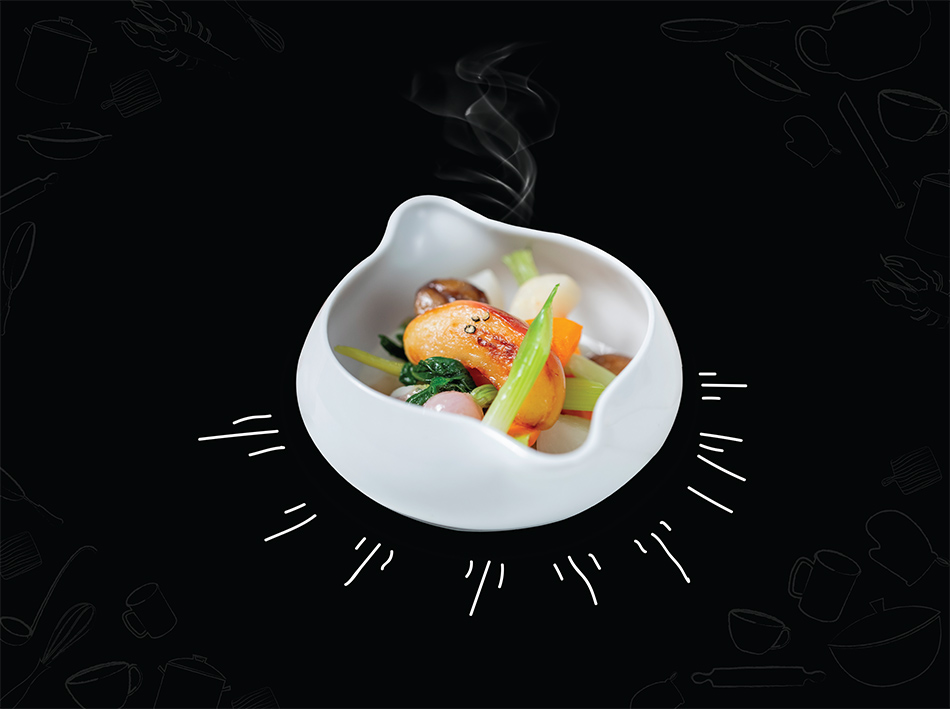
Inspired by the cooking pot used by people in rural France for centuries, Ducasse has developed his own version and called it Cookpot
Not many would associate a signature dish by one of the most renowned French chefs with vegetables. But Alain Ducasse has indeed developed one such dish that combines history and tradition with today’s times. Inspired by the cooking pot used by people in rural France for centuries, Ducasse has developed his own version and called it Cookpot in which he cooks his eponymous dish. These porcelain pots are made in the Berry region of France by Pillivuyt, one of the country’s oldest porcelain manufacturers.
The principle of the dish is simple. Indeed, the dish can be considered local in any part of the world and the mix of vegetables or spices changing by location and season. Throughout the world, recipes are revisited according to the place and the seasons; always respecting the Chef’s philosophy in which vegetables have a primordial place.
SEALED COOKPOT WITH VEGETABLES (SERVES 4)
Ingredients
- 4 new carrots with tops
- 1 rutabaga
- 2 martin Sec pears
- 1.5l white chicken stock
- 150ml chicken jus
- 1 butternut squash
- 100g chestnuts cooked sous-vide
- 2 yellow beets
- 1 quince
- Olive oil (as needed)
- 20g butter
- Ascorbic acid (as needed)
- Fine salt (as needed)
- 1 clove garlic
Sealing dough
- 500g cake flour
- 5g salt
- 14g sugar
- 250g egg
- 140g egg white
- 1/4 bunch rosemary, chopped
Directions
FOR THE VEGETABLES
Peel and wash the carrots, keeping their tops. Set aside in an ice bath.
Wash the pears. Halve them, then round off any sharp angles and deseed. Set aside in water with ascorbic acid.
Cut each yellow beet into 4 oval disks approximately 4cm in diameter and 1.5cm thick, then round off any sharp angles. Set aside in an ice bath.
Peel and wash the rutabaga. Cut it into 8 oval disks approximately 4cm in diameter and 1.5cm thick, then round off any sharp angles. Set aside in an ice bath.
Peel the squash. Cut it into 8 equilateral triangles with 4cm sides and 1.5cm thick, then round off any sharp angles.
Peel the quince. Cut it into 8 segments, removing any seeds and rounding off any sharp angles. Set aside in water with ascorbic acid.
For finishing: Cut the remaining pear into 1mm slices and set aside in water with ascorbic acid. Drain and chop the chestnuts.
COOKING THE VEGETABLES
Heat a little olive oil in a cast-iron pan. Sweat the yellow beet disks, then shallow braise them in the white chicken stock with the lid on.
Repeat this operation with the rutabaga, butternut squash, and carrots (they should be cooked until “al dente”).
Heat a little olive oil in a large cast-iron pan. Brown the quince and season with salt.
Cover and cook for 20–25 minutes in low heat. Moisten with white chicken stock if necessary while cooking.
After cooking each respective ingredient, drain and cool in a blast chiller.
Strain the cooking liquid from each. Cool in a blast chiller.
Heat a little oil in a sauté pan and brown the pears. Season with salt.
Once cooked, drain them and set aside.
Combine the different cooking liquids.
Add the butter and a little olive oil. Gently heat and reduce by a third to the consistency of a slightly thickened jus, then add the chicken jus.
Adjust the seasoning and set aside.
FOR THE SEALING DOUGH
Mix all the ingredients together then transfer to the counter and knead. Rest the dough.
Shape the dough into rolls and let rest before rolling them out into fine strips.
FINISHING AND SERVING
Rub the inside of 4 individual ramekins or casserole dishes with the garlic clove cut in half and arrange the vegetables harmoniously inside, alternating them.
Moisten them with the cooking liquid from the vegetables.
Seal the cookpots or casserole dishes with the dough, brush with glaze and cook in the oven at 180ºC for 15 minutes.
Serve the cookpots or casserole dishes immediately after cooking.
Profile of Chef

Cédric Barbarat, executive chef at Ecole Ducasse
Paris Studio Cédric Barbarat began his career alongside Alain Ducasse in 2003 as a sous-chef at La Cour Jardin restaurant at Plaza Athénée, a leading palace hotel in Paris, where he held the role for 3 years. Further on, he continued to work with various Parisian gastronomic restaurants before finally joining the team of the Alain Ducasse Cooking School – initially as a sous-chef rising over the years to become the executive chef.





















